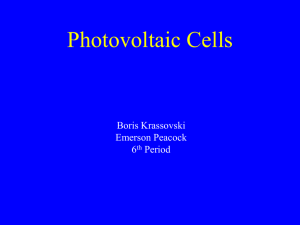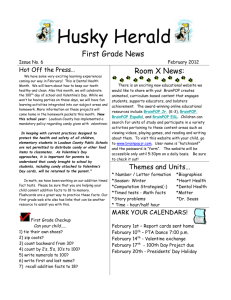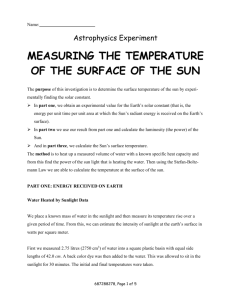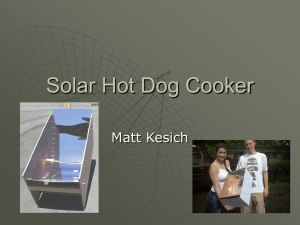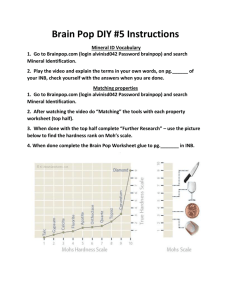Science -1 - Mentor School District
advertisement
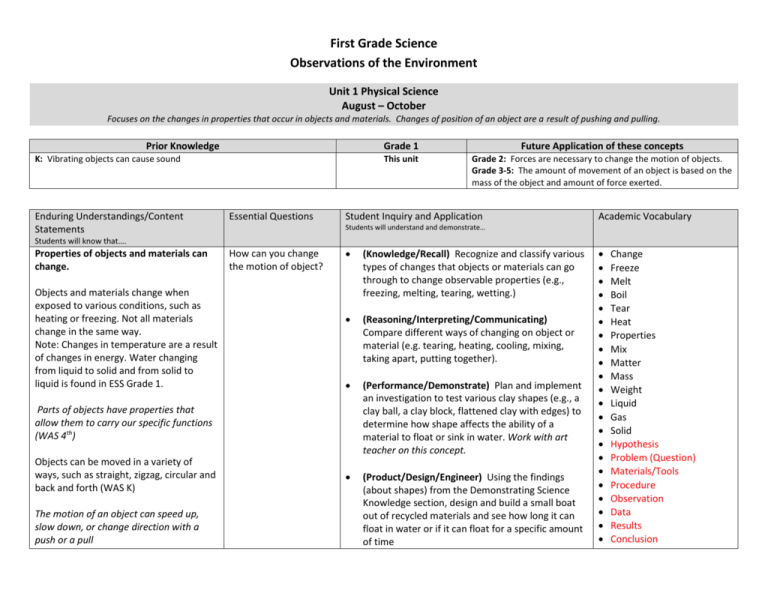
First Grade Science Observations of the Environment Unit 1 Physical Science August – October Focuses on the changes in properties that occur in objects and materials. Changes of position of an object are a result of pushing and pulling. Prior Knowledge K: Vibrating objects can cause sound Enduring Understandings/Content Statements Essential Questions Grade 1 Future Application of these concepts This unit Grade 2: Forces are necessary to change the motion of objects. Grade 3-5: The amount of movement of an object is based on the mass of the object and amount of force exerted. Student Inquiry and Application Academic Vocabulary Students will understand and demonstrate… Students will know that…. Properties of objects and materials can change. Objects and materials change when exposed to various conditions, such as heating or freezing. Not all materials change in the same way. Note: Changes in temperature are a result of changes in energy. Water changing from liquid to solid and from solid to liquid is found in ESS Grade 1. How can you change the motion of object? (Knowledge/Recall) Recognize and classify various types of changes that objects or materials can go through to change observable properties (e.g., freezing, melting, tearing, wetting.) (Reasoning/Interpreting/Communicating) Compare different ways of changing on object or material (e.g. tearing, heating, cooling, mixing, taking apart, putting together). (Performance/Demonstrate) Plan and implement an investigation to test various clay shapes (e.g., a clay ball, a clay block, flattened clay with edges) to determine how shape affects the ability of a material to float or sink in water. Work with art teacher on this concept. (Product/Design/Engineer) Using the findings (about shapes) from the Demonstrating Science Knowledge section, design and build a small boat out of recycled materials and see how long it can float in water or if it can float for a specific amount of time Parts of objects have properties that allow them to carry our specific functions (WAS 4th) Objects can be moved in a variety of ways, such as straight, zigzag, circular and back and forth (WAS K) The motion of an object can speed up, slow down, or change direction with a push or a pull Change Freeze Melt Boil Tear Heat Properties Mix Matter Mass Weight Liquid Gas Solid Hypothesis Problem (Question) Materials/Tools Procedure Observation Data Results Conclusion Resources: Will It Float? http://www.uen.org/Lessonplan/preview?LPid=5673 Changing Matter http://www.uen.org/Lessonplan/preview?LPid=5676 Writing about Vehicles That Float http://www.uen.org/Lessonplan/preview?LPid=5682 Matter… It Does! http://www.uen.org/Lessonplan/preview?LPid=28155 Melted crayon art - http://www.52kitchenadventures.com/2011/09/12/melted-crayon-art-tutorial/ and nice heart-shaped or circular crayons (melted in a muffin tin) http://frugalliving.about.com/od/frugalfun/ht/Make_Crayons.htm Kitchen Magician is a game from PBS Kids that emphasizes how materials can change during cooking: http://pbskids.org/sid/kitchenmagician.html Scott-Foresman: Pages 209 – 237; Leveled Readers: Changing Shape, Energy, Learning About Energy Imagine It! Decodables (Book 1): Frozen, (Book 2): Paul’s Sauce (mixing) Review (if needed from K) BrainPop Solids, Liquids, Gases movie: http://www.brainpopjr.com/science/matter/solidsliquidsandgases/ BrainPop Movie – Physical and Chemical Changes : http://www.brainpopjr.com/science/matter/physicalandchemicalchanges/ BrainPop Make Your Own Volcano Activity (Physical and Chemical Change): http://www.brainpopjr.com/science/matter/physicalandchemicalchanges/activity/ BrainPop Movie – Changing State of Matter: http://www.brainpopjr.com/science/matter/changingstatesofmatter/ BrainPop – Disappearing Water Activity (Changing State of Matter): http://www.brainpopjr.com/science/matter/changingstatesofmatter/activity/ BrainPop Changing State of Matter Activities: http://www.brainpopjr.com/science/matter/changingstatesofmatter/grownups.weml BrainPop Simple Machines Activity: http://www.brainpopjr.com/science/forces/simplemachines/activity/ Assessment: Forces and Movement Online Quiz: http://www.bbc.co.uk/schools/scienceclips/ages/6_7/forces_movement.shtml BrainPop Pushes and Pulls Easy Quiz: http://www.brainpopjr.com/science/forces/pushesandpulls/easyquiz/ BrainPop Pushes and Pulls Write About It: http://www.brainpopjr.com/science/forces/pushesandpulls/writeaboutit/ Earth and Space January-March Big Idea 1: The sun is our source of energy Prior Knowledge (base knowledge) Grade 1 Future Application of these concepts PreK-K: Weather changes every day, weather changes are short and long term, the sun is visible during the day and the position of the sun can change. this unit Grades 2: The relationship between energy and long- and short-term weather is introduced. Enduring Understandings Content Statement Sunlight warms Earth’s land, air, and water. The amount of exposure to sunlight affects the amount of warming or cooling of air, water, and land. Student Inquiry and Application (Guidance for developing performance tasks) Essential Questions Students will know that… The sun is the principal source of energy. Grade 3-5: Renewable energy, forms of energy (e.g., heat, light, electrical energy), the solar system and patterns/cycles between the Earth and sun Why does temperature change? What causes it to change? Academic Vocabulary Students will understand and demonstrate… (Knowledge/Recall) Recognize that sunlight warms water, air and soil. Identify that sun is a primary source of energy. Select a grassy area in full sun, in partial sun or in shade and collect temperature readings. Describe and write how certain areas of Earth are warmer/heated by sunlight and how some are not. Energy - seeing and feeling air and water movement, feeling heat from sunlight) (Reason/Interpret) Use appropriate tools and measurements to observe and document the warming and cooling of air, water, or soil. The length of time an object or material (including water) is exposed to sunlight and its resulting temperature must be observed, as should the amount of time for the object or material to cool down after it is taken out of the sunlight. (i.e. solar device, cold frame) thermometer solar energy solar heating observe/observati on temperature measurement compare How does the energy from the sun change the land, air and water? (Perform/Demonstrate) Use appropriate tools and technology to collect, compare and document data (graph, chart or table to record the data). Investigation and experimentation must be combined with explanation, questioning, and discussion of the results and findings. Build a model to collect or use solar energy (i.e., solar oven, solar wind chimes, solar heating device). Compare how long it takes to heat samples of water/soil/air to specific temperature using sun. Resources: cold frame (Product/Design/Engineer) Make a mini cold frame that can be used to protect plants from cold temperatures. Use recyclable materials (i.e., plastic bottles, milk jugs or cartons). Compare and evaluate the placement of the cold frame to get the most autumn/winter sunlight. Collect data (temperature, water, outside weather, amount of daily sunlight) to use in the comparison. Sciencea-z.com: http://www.sciencea-z.com/scienceweb/unit/Weather?unitId=14 http://amasci.com/miscon/opphys.html : Examples of student misconceptions about the sun and energy through investigations. Literacy text – Igloo: A House of Snow and Ice http://www-istp.gsfc.nasa.gov/istp/outreach/sunearthmiscons.html :Lists common misconceptions about the sun and Earth, providing students with opportunities to experiment and explore the sun and solar energy. Science based story books from the Primary GLOBE Program: http://www.epa.ohio.gov/Portals/42/documents/AA%20wetlands%201%20fixed.pdf (project books to whole class, printable too) Additional teacher information: http://epa.ohio.gov/Portals/42/documents/Websites-favorites.pdf - See page 7, Energy Efficiency (solar energy) http://epa.ohio.gov/Portals/42/documents/Websites-favorites.pdf - See page 12, Local Environmental Conditions in Ohio Ohio wetlands: http://www.epa.ohio.gov/Portals/42/documents/AA%20wetlands%201%20fixed.pdf Uncovering Student Ideas in Science, Volume 4: 25 New Formative Assessment Probes : http://learningcenter.nsta.org/search.aspx?action=browse&text=page%20keeley&price=0&product=0&subject=42&topic=452&gradelevel=0&sort=Relevancy PBS Link to Exploring Weather Lesson Plan Ideas PBS Lesson Plan/Short Video Clip Measuring the Temperature PBS Computer Interactive - Water We Doing http:sciencenetlinks.com/lessons/the-warmth-of-the-sun/ http://www.tumblebooks.com/library/asp/full_book.asp?ProductID=4561 Assessments: What would life be like if there was no sun? Is it usually warmer during the day or night? Why? Do you think things like rocks, grass, leaves, water, or air are cooler or warmer in the sun? In the shade? If they were taken indoors? Why or why not? In what ways do plants and animals count on the sun? What observable evidence do we have that the sun is the primary source of energy? Compare the results of data collected (graph/chart/table) in writing and orally. Why do some colors or materials work best for collecting sun as a source of energy? Where does the solar device work best? Why? What can be done to make the solar device work better? Compare the data from the cold frames. Why did this plant grow better than the other plant? (variables: sunlight, water, temperature, outside weather) Why is changing temperatures on air, land, or water important for people who work with plants, people who build ponds filled with fish and plants, people who boat…? Grade 1 - Life Science (LS) April-May Basic Needs of Living Things Focus on the physical needs of living things in Ohio (i.e., energy from the sun or food, nutrients, water, shelter and air). Big Idea: Living things meet their basic needs for survival by obtaining resources from their environment. Prior Knowledge (base knowledge) K: Living things are different from nonliving things; Living things have physical traits and behaviors, which influence their survival. Enduring Understandings Content Statements Students will know that… Living things have basic needs, which are met by obtaining materials from the physical environment. Earth has many different environmental conditions that support living things. Living things require living (plants and animals) and nonliving (water, sunlight, air, nutrients, particular temperatures/climate) resources in their environments. Plants get energy from sunlight. Animals get energy from plants and other animals. Living things survive only in environments that meet their needs Resources are necessary to meet the needs of an individual and populations Essential Questions How does the environment help living things survive? Grade 1 this unit Future Application of these concepts Grades 2: Living things cause changes on Earth/impact the environment; the environment impacts living things. Student Inquiry and Application Students will understand and demonstrate… (Knowledge/Recall) Identify the basic survival needs of plants and animals (classroom pets, plants around school). (Reasoning/Interpreting) Based on observations of birds in the field (ie., bird stations around school), compare the food choices of birds in the study and create a chart to communicate findings; Explain, draw, journal and photograph what happens to local living and nonliving environments over time. (Performance/Demonstrate) Plan and implement a classroom investigation to monitor a plant or animal over time (i.e., simple pinecone bird feeder, cover pinecones with vegetable shortening and coat with one type of food such as black or striped sunflower seeds, millet, cracked corn, or thistle) Does the type of food influence what type of birds will come to a bird feeder? (Product/Design/Engineer) Using data from Academic Vocabulary physical needs energy nutrients shelter basic needs obtain, acquire physical environment require environment resources components survive reproduce observation individual organisms population interact change, impact habitat climate hypothesis of individuals. Living things interact with their physical environments as they meet those needs. Effects of seasonal changes within the local environment directly impact the availability of resources. the classroom investigation, students design their own investigation. Share designs, results and recommendations with an authentic audience. Example: bird feeder and blend of birdseed that will attract the most birds of one kind or the greatest variety of birds problem (question) materials/tools procedure data results conclusion Resources: http://kids.nationalgeographic.com/kids/animals/creaturefeature/ http://www.nsta.org/about/positions/animals.aspx - National Science Teachers Association (NSTA) position paper to provide guidance on ethical treatment of animals and safety employed in the classroom. http://www.teachersdomain.org/asset/tdc02_vid_plantsgrow/ http://www.unitedstreaming.com/videos/dsc/externalApplications/virtual_labs-es/Plants/index.html
